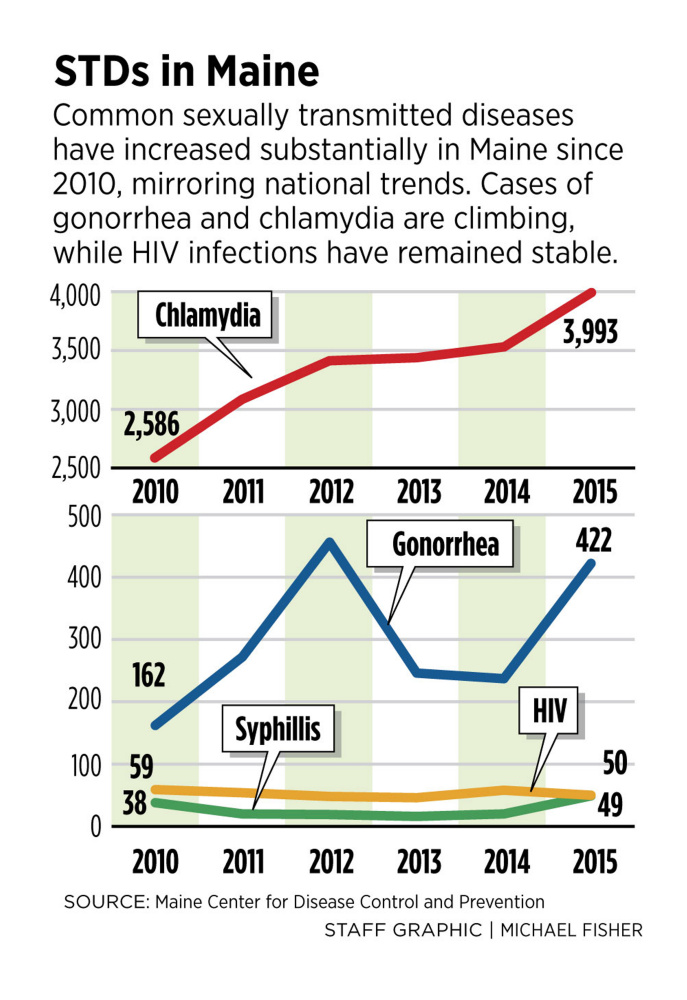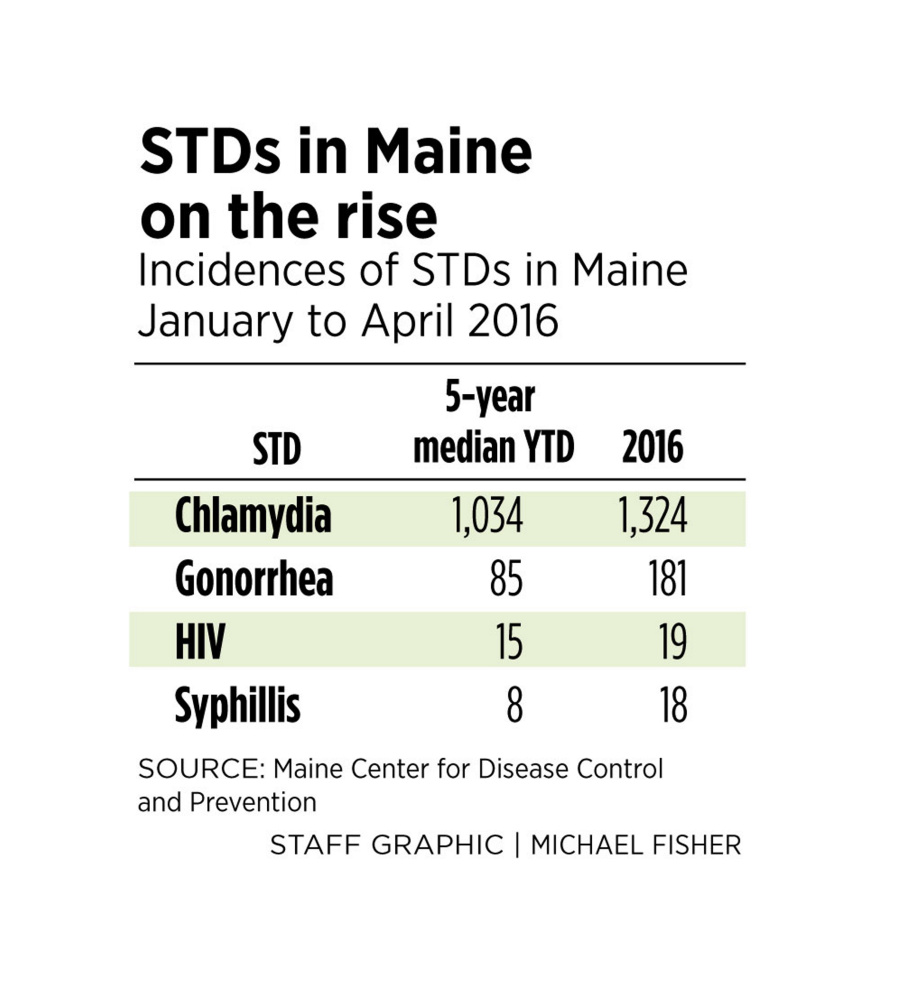Common sexually transmitted diseases infected Mainers in much higher numbers in 2015 and are on pace through the first four months of 2016 to match or be worse than last year.
The increase mirrors a nationwide trend of rising rates of STDs, especially among young people.
Through April 30, 1,324 Mainers had contracted chlamydia, about 30 percent higher than the five-year median for the first four months of the year, according to the Maine Center for Disease Control and Prevention. Chlamydia is on track to nearly match the 3,993 cases in 2015, and is substantially higher than the 2,586 cases recorded in 2010.
Meanwhile, gonorrhea, with 181 cases through April, is on track to infect nearly 550 people in 2016, far surpassing the 422 reported in 2015 and more than tripling rates seen in 2010. In contrast, rates of HIV infections have remained steady at about 50 per year, while syphilis cases have seen slight increases, with 50 cases last year.
The U.S. Centers for Disease Control and Prevention reported late last year that in 2014, chlamydia and gonorrhea cases increased to 1.4 million and 350,000, respectively.
The higher rates of chlamydia and gonorrhea are worrisome, public health experts say.
“This is extraordinarily high,” said Dr. Dora Anne Mills, a vice president at the University of New England and former director of the Maine CDC. Mills said it’s difficult to pinpoint a reason for the increased infection rates, but perhaps complacency has set in among young people, who tend to be the most sexually active. For example, 2,389 of the chlamydia cases and 230 of the gonorrhea cases in 2015 were contracted by those in the 20-29 age group.
Dr. Caroline Teschke, director of India Street Clinical Services in Portland, said it’s a “complex” topic, but she believes a contributing factor is the reduction of AIDS cases in comparison to the 1980s and 1990s – people don’t fear the consequences of having unprotected sex.
Teschke said people who are at risk of HIV infection are taking pre-exposure prophylaxis pills, which are effective at preventing HIV. They are supposed to be used in conjunction with condoms, but many people are not using condoms.
“Maybe people are willing to take more risks if they’re not as much worried about HIV infections, and they don’t see people dying around them,” she said.
But Teschke noted that the more common STDs, if left untreated, can cause many lifelong problems, including infertility and pelvic inflammatory disease. “These are serious diseases,” she said. “In a modern society, we should and can do better.”
Despite the spike in STDs, Maine has low rates compared with other states, ranking 49th nationally for chlamydia and 48th for gonorrhea.
Teschke said other factors could be cultural, technological and the public’s continued resistance to using condoms, one of the most effective ways of preventing STDs.
“Let’s face it, people don’t love condoms, and they don’t want to use them,” Teschke said.
John Martins, spokesman for the Maine CDC, said there’s “no single reason” why STDs are on the rise across the country or in Maine.
“There are multiple factors that could contribute to the rise in STDs. They include: People who are infected may have unprotected sex, people may have more sexual partners, and people may be unaware they are infected and may not seek testing because they feel healthy,” Martins said in a written statement.
He said the state spends about $275,000 per year on STD prevention programs.
Maine Family Planning, an Augusta nonprofit advocacy group that promotes safe sex, publishes a recommended “best practices” guide for reproductive health curricula in Maine schools, including STD prevention.
Lynette Johnson, director of prevention programs for Maine Family Planning, said the organization has revamped its curriculum to emphasize why using a condom is important. She said the new curriculum was tested as a pilot program in several schools last year, and will be rolled out in many schools this fall.
Johnson noted that there are more pregnancy prevention options for women and many of them are convenient and extremely effective, such as the birth control shot, which only needs to be taken once every 12 weeks. But while a shot is effective in preventing pregnancy, it doesn’t prevent STDs.
“Our message is that it’s not just about preventing pregnancy, but that you should be using condoms to prevent STDs,” Johnson said.
She said another issue is that teens who have sex often use condoms at first, but then stop after they get in a long-term relationship. But the relationship may not be monogamous or last as long as the teens believe it will, Johnson said.
Teschke said condoms are free at the India Street clinic, which gives out about 20,000 of them per year, but the general population may not be aware they are available.
The city-run clinic is closing, with many services being transferred to Portland Community Health Center, a community clinic, by the end of the year. But the India Street clinic’s STD screening and prevention services will continue for at least another year during the transition.
Send questions/comments to the editors.





Comments are no longer available on this story